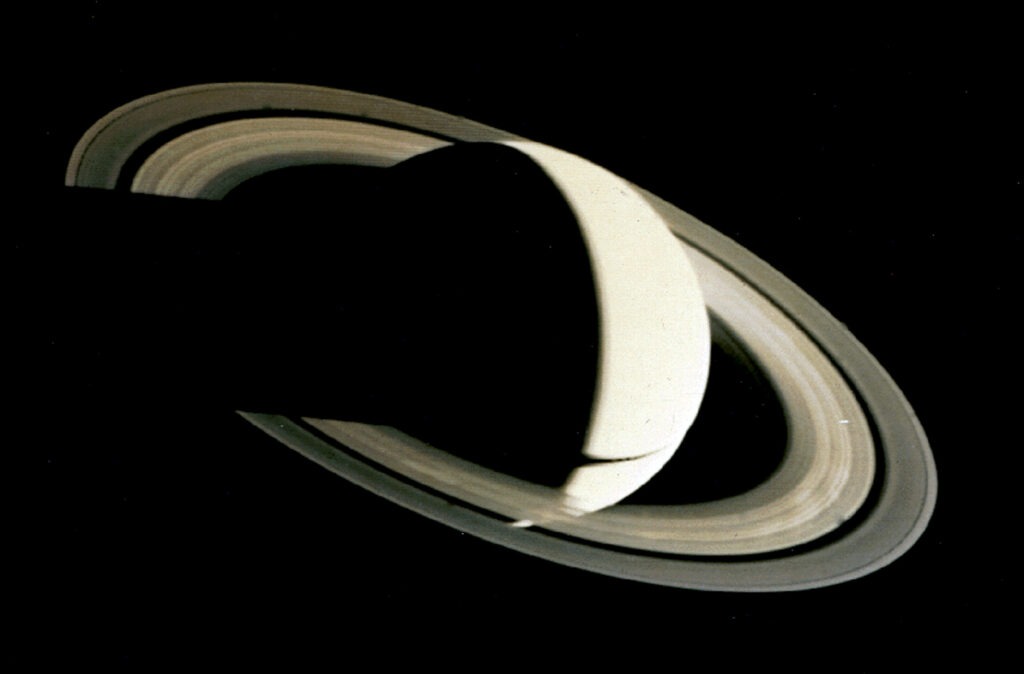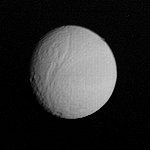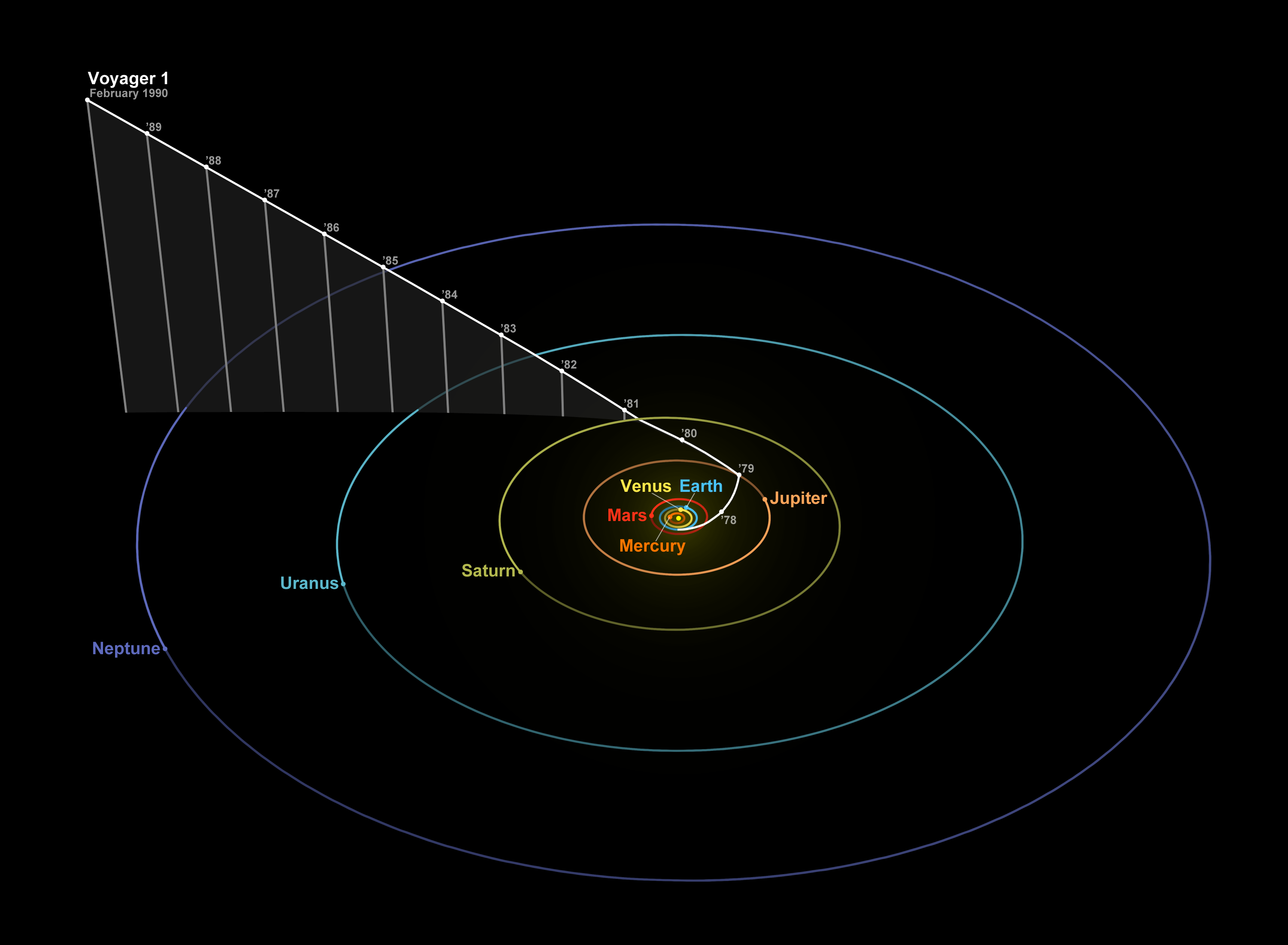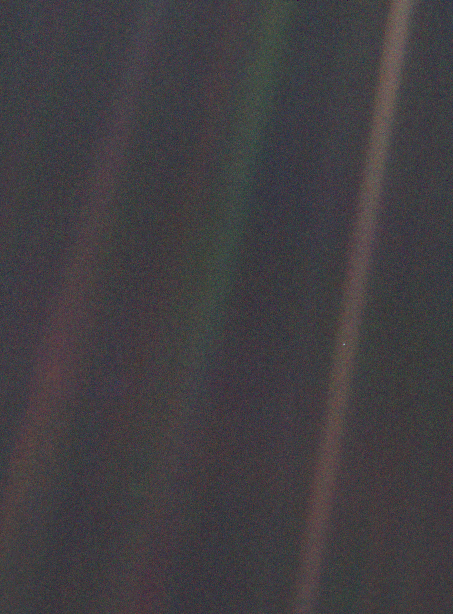Flyby of Saturn
Both of the Voyagers successfully executed gravitational assist trajectories at Jupiter and proceeded to visit Saturn and its system of moons and rings. Voyager 1 encountered Saturn in November 1980, when the closest approach was on November 12, 1980, at a distance of 124,000 kilometres (77,000 mi) from Saturn’s cloud-tops. The cameras of the space probe detected complex structures in the rings of Saturn, and its remote sensing instruments studied the atmospheres of Saturn and its giant moon Titan.

Voyager 1 · Jupiter · Io · Europa · Ganymede · Callisto
Voyager 1 measured that around seven percent of the volume of Saturn’s upper atmosphere is helium compared to 11 percent in the case of Jupiter, and almost all the rest is hydrogen. Since the internal helium abundance of Saturn was expected to be the same as that of Jupiter and the Sun, the lower abundance of helium in the upper atmosphere may imply that the heavier helium may be slowly sinking through Saturn’s hydrogen; that might explain the excess heat that Saturn radiates over energy it receives from the Sun. Winds blow at high speeds on Saturn. The winds near the equator measured by the Voyagers were around 500 m/s, which is equivalent to 1,100 mph. Wind blows primarily eastward.
The Voyagers detected aurora-like ultraviolet emissions of hydrogen at mid-latitudes in the atmosphere, and auroras at polar latitudes (above 65 degrees). The high-level auroral activity may lead to the formation of complex hydrocarbon molecules that are carried toward the equator. The mid-latitude auroras, which occur only in sunlit regions, remain a puzzle, since bombardment by electrons and ions, known to cause auroras on Earth, occurs primarily at high latitudes. Both Voyagers measured the rotation of Saturn (the length of a day) at 10 hours, 39 minutes, 24 seconds.
Voyager 1 also came with a flyby mission over Titan, one of the largest moons of Saturn and known for a long time to have a substantial atmosphere. Images from Pioneer 11 in 1979 had indicated that the atmosphere was large and complex, further added interest.
The Titan flyby occurred as the spacecraft entered the system to avoid any possibility of damage closer to Saturn compromising observations, and approached to within 6,400 km (4,000 mi), passing behind Titan as seen from Earth and the Sun.
Voyager’s measurement of the atmosphere’s effect on sunlight and Earth-based measurement of its effect on the probe’s radio signal were used to determine the atmosphere’s composition, density, and pressure.
This has also allowed astronomers to calculate Titan’s mass based on its impact on the probe’s trajectory. The thick haze obscures direct visual observation of the surface, but composition measurements in the atmosphere with temperature and pressure have raised speculations of possible lakes of liquid hydrocarbons existing on the surface.
Because observations of Titan were considered critical, the Voyager 1 trajectory was worked up around the best Titan flyby. This placed Voyager 1 below the south pole of Saturn and took it out of the plane of the ecliptic, thus ending its planetary science mission. Had Voyager 1 failed or been unable to observe Titan, Voyager 2’s trajectory would have been altered to incorporate the Titan flyby, precluding any visit to Uranus and Neptune. The trajectory Voyager 1 was launched into would not have allowed it to continue on to Uranus and Neptune, but could have been altered to avoid a Titan flyby and travel from Saturn to Pluto, arriving in 1986.








Voyager 1 Exit from the heliosphere
On February 14, 1990, Voyager 1 captured the first ‘family portrait’ of the Solar System as seen from outside, which includes the image of planet Earth known as Pale Blue Dot. Soon after that, its cameras were shut down to save energy and computer resources for other equipment.

The camera software has been removed from the spacecraft, so it would now be complex to get them working again. The earth-side software and computers to read the images are no longer available either.
On February 17, 1998, Voyager 1 attained a distance of 69 AU (6.4 billion mi; 10.3 billion km) from the Sun and took over from Pioneer 10 as the most distant spacecraft from Earth. It travels at about 17 km/s (11 mi/s), making its heliocentric recession speed the fastest of any spacecraft.

As Voyager 1 headed for interstellar space, its instruments continued to study the Solar System. Jet Propulsion Laboratory scientists used the plasma wave experiments aboard Voyager 1 and 2 to look for the heliopause, the boundary at which the solar wind transitions into the interstellar medium.
As of 2013, the probe was moving with a relative velocity to the Sun of about 61,197 kilometres per hour (38,026 mph). With the velocity the probe is currently maintaining, Voyager 1 is traveling about 523 million km (325 million mi) per year, or about one light-year per 18,000 years.
Termination shock
The scientists of the Johns Hopkins University Applied Physics Laboratory think that Voyager 1 crossed into the termination shock region in February 2003. The termination shock marks the location at which the solar wind has slowed to subsonic velocities.
Other scientists expressed skepticism and aired their concerns in the journal Nature of November 6, 2003. The question could not be resolved until other information was available since Voyager 1’s solar-wind detector failed in 1990. Termination shock detection would have to be inferred from the data obtained from the other instruments on board.
In May 2005, a NASA news release stated that consensus was such that Voyager 1 was in the heliosheath. Evidence that the craft crossed the termination shock, was presented on May 25, 2005, during a scientific session at the American Geophysical Union meeting in New Orleans by Ed Stone. This occurred is estimated to have occurred on 15 December, 2004 at a distance of 94 AU (8,700 million mi) from the Sun.

Heliosheath
On 31 March 2006, the amateur radio operators from AMSAT in Germany successfully tracked and received Voyager 1’s radio waves with a long integration technique using the 20-metre (66 ft) dish at Bochum. The retrieved data were checked and verified against the data at the Deep Space Network station at Madrid, Spain. This appears to be the first time amateur tracking is followed for the spacecraft.
It was on December 13, 2010, that it was confirmed that Voyager 1 had passed the radial outward flow of the solar wind. The Low Energy Charged Particle device measured this distance. It is suspected that solar wind at this distance turns sideways because of interstellar wind pushing against the heliosphere. Since June 2010, detection of solar wind had been consistently at zero, providing conclusive evidence of the event. It was around 116 AU, or 17.4 billion kilometers; 10.8 billion miles from the Sun at this time.
Voyager 1 was instructed to roll over to observe the sideways motion of the solar wind at that point in space in March 2011 (~33 years 6 months after launch). A test roll had been performed in February and had verified that the spacecraft could roll and reorient itself. The trajectory of the spacecraft was not altered. It rolled 70 degrees counterclockwise relative to Earth to observe the solar wind.
It marked the first serious maneuver for this spacecraft since taking the Family Portrait photograph of the planets back in 1990. Having been rolled over, the spacecraft posed no challenge whatsoever in aligning itself again to Alpha Centauri, its guiding star on this journey of Voyager 1 and resumed transmission toward Earth.
Voyager 1 was expected to reach interstellar space ‘at any time.’ Voyager 2 still detected outward flow of solar wind at that point but was estimated to experience the same conditions as Voyager 1 in the following months or years.
The spacecraft was reported at 12.44° declination and 17.163 hours right ascension, and at an ecliptic latitude of 34.9° (the ecliptic latitude changes very slowly), placing it in the constellation Ophiuchus as observed from the Earth on May 21, 2011.
Lyman-alpha radiation originated from the Milky Way galaxy first detected by Voyager 1 in December 1st, 2011. Initially, Lyman-alpha radiation is detected from various galaxies; but due to sunlight interference, scientists could not spot the Milky Way’s radiation at all.
On December 5, 2011, NASA declared that Voyager 1 had entered a new region called ‘cosmic purgatory.’ Within this stagnation region, charged particles streaming from the Sun slow and turn inward, and the Solar System’s magnetic field is doubled in strength as interstellar space appears to be applying pressure. Energetic particles originating in the Solar System fall by about half, while the detection of high-energy electrons from outside increases 100-fold. The inner edge of the stagnation region is located about 113 AU from the Sun.
Heliopause
NASA reported in June 2012 that the spacecraft was detecting changes in the environment that were suspected to correlate with arrival at the heliopause. Voyager 1 had reported a marked increase in its detection of charged particles from interstellar space, which are normally deflected by the solar winds within the heliosphere from the Sun. The craft thus began to enter the interstellar medium at the edge of the Solar System.
Voyager 1 became the first spacecraft to cross the heliopause in August 2012, then at a distance of 121 AU (1.12×10¹⁰ mi; 1.81×10¹⁰ km) from the Sun, although this was not confirmed for another year.
As of September 2012, sunlight reached Voyager 1 after a time lapse of 16.89 hours, as the spacecraft was situated at a distance of 121 AU. The apparent magnitude of the Sun in the spacecraft’s view was −16.3, or about 30 times brighter than the full Moon. The spacecraft moved at 17.043 km/s or 10.590 mi/s relative to the Sun.
At this rate, it would take approximately 17,565 years at this speed to travel one light-year. To put that into perspective, Proxima Centauri, the closest star to the Sun, is about 4.2 light-years (2.65×10⁵ AU) away. If the spacecraft was moving in the direction of that star, it would take 73,775 years to get there. (Voyager 1 is traveling in the direction of the constellation Ophiuchus.)
Late in 2012, researchers announced that the particle data returned from the spacecraft showed that the probe had already moved through the heliopause. The measurements coming back from the spacecraft showed a constant increase since May of collisions by high-energy particles-over 70 MeV-said to be cosmic rays generated in supernova explosions light-years outside the Solar System, and showed a rapid jump in late August. At the same time, in late August, collisions with low-energy particles, which are believed to come from the Sun, dropped dramatically.
Ed Roelof, space scientist at Johns Hopkins University and principal investigator for the Low-Energy Charged Particle instrument on the spacecraft, declared that ‘most scientists involved with Voyager 1 would agree that [these two criteria] have been sufficiently satisfied.’
However, the last criterion for officially declaring that Voyager 1 had crossed the boundary, the expected change in magnetic field direction (from that of the Sun to that of the interstellar field beyond), had not been observed (the field had changed direction by only 2 degrees), which suggested to some that the nature of the edge of the heliosphere had been misjudged.
Said Ed Stone, the Voyager project scientist at the California Institute of Technology, on 3 December 2012, “Voyager has discovered a new region of the heliosphere that we had not realised was there. We’re still inside, apparently. But the magnetic field now is connected to the outside. So it’s like a highway letting particles in and out.’ The magnetic field in this region was 10 times more intense than Voyager 1 encountered before the termination shock. It was to be the final barrier before the spacecraft completely escaped the Solar System and entered into interstellar space.
Communication issues
In May 2022, NASA announced that Voyager 1 was sending ‘bizarre’ and ‘strange’ telemetric data to the Deep Space Network (DSN). It confirmed that the operational status of the craft remained unchanged but said that the problem was with the Attitude Articulation and Control System (AACS).
NASA’s Jet Propulsion Laboratory released a statement on May 18, 2022, saying that the AACS was working but reporting incorrect data. The problem was traced to the AACS sending its telemetry through a computer that had been non-operational for years, which caused data corruption.
In August 2022, NASA sent a command to the AACS to use another computer, which solved the problem. An investigation into what caused the initial switch is underway, though engineers have hypothesized that the AACS had executed a bad command from another onboard computer.
Voyager 1 started transmitting unintelligible data on November 14, 2023. NASA announced on December 12, 2023, that the flight data system of Voyager 1 was not able to employ its telemetry modulation unit due to which it could not transmit scientific data. NASA announced on March 24, 2024, that they had made much progress in the interpretation of data received from the spacecraft.
Engineers reported in April 2024 that the failure was likely in a memory bank of the Flight Data Subsystem (FDS), one of the three onboard computer systems, probably from being struck by a high-energy particle or that it just wore out due to age. The FDS was not communicating correctly with the TMU, which began transmitting a repeating sequence of ones and zeros that indicated the system was in a stuck condition.
After the FDS rebooted, communications remained unusable. The probe still received commands from Earth and was sending a carrier tone that indicated it was still operational. The change in the modulation of the tone resulted from commands that changed the modulation; therefore, all was not lost, as it confirmed that the probe was responsive.
The team on Voyager developed a workaround; communication of health and status was restored April 20 when code was rearranged away from the defective FDS memory chip. This had only three percent damaged beyond repair. Because the memory is corrupted, the code needed to be relocated, but there were no places for an extra 256 bits; the spacecraft’s total memory is only 69.63 kilobytes.
To make it work, the engineers deleted unused code, for example, the code used to transmit the data from Jupiter, that cannot be used at the current transmission rate. All the data from the ‘anomaly period’ is lost. May 22: NASA announced that Voyager 1 ‘resumed returning science data from two of its four instruments,’ with work towards the others ongoing. June 13: NASA confirmed that the probe returns data from all four instruments.
In October 2024, the probe turned off its X-band radio transmitter that it was using for communication with the DSN. This was caused by the fault protection system that had been activated in the probe when NASA had activated one of its heaters on October 16. The fault protection system had decreased the rate of transmission but engineers were still able to detect the signal. Later, on October 19, the transmission stopped; the fault protection system was triggered once again and switched to the S-band transmitter, which was used in 1981. According to NASA, the team restored the X-band transmitter and continued collecting data mid-November.
Golden record
Each of the Voyager space probes has a gold-plated audio-visual disc, which is actually a compilation showing the diversity of life and culture on Earth in case either of the spacecraft is one day found by some extraterrestrial discoverer.

The record, produced under the guidance of a team that includes Carl Sagan and Timothy Ferris, consists of images of the Earth and its inhabitants, a variety of scientific data, spoken messages from individuals like the Secretary-General of the United Nations (Kurt Waldheim) and the President of the United States (Jimmy Carter) and a tapestry, ‘Sounds of Earth’, that contains whale sounds, the wail of a crying infant, waves pounding on a shore, and an assortment of music from various civilizations and time frames including compositions by Wolfgang Amadeus Mozart, Blind Willie Johnson, Chuck Berry, and Valya Balkanska.
Other Eastern and Western classics are featured, along with indigenous and folk music performances from every corner of the globe. The album is also filled with messages in 55 languages. The idea behind the project was to capture the diversity of life on Earth and be a witness to human imagination and the desire to connect to the universe
Latest Updates







 Let’s imagine, explore, and uncover the mysteries together!
Let’s imagine, explore, and uncover the mysteries together!